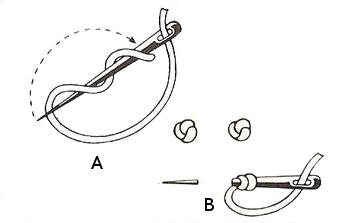
Knotted Stitch or French Knot is used for the centres of such flowers as the daisy or wild rose, and sometimes for the anthers of others. It isn’t very easy to be precise on the number of threads in the needle to work a French Knot. I
t depends on the effect you require and for that you will need to practise the stitch on a spare piece of canvas. I feel it is better to have a small number of strands in the needle and work more loops, for an airier effect.
The French Knot is useful for many decorative effects.
It can be worked tightly or loosely, small or large, depending on the number of loops on the needle and how tightly they are pulled through the canvas. It is great fun to work and gives tremedous scope for depicting all types of flowers and dense shrubs.
To do french knot:
- bring the thread up at the desired place,
- wrap the thread twice around the point of the needle and
- re-insert the needle
- hold down the thread firmly with the thumb and pull the needle through smoothly and swiftly.
The knots should be kept neat and precise and look like little round beads. To increase the size of the knots, use a thicker thread or more strands of the same thread.
French Knot is a very ancient stitch, and does not seem confined to any country. The Chinese execute large and elaborate pieces of embroidery in it, introducing beautiful shading. A curious specimen of very fine knotting stitch was exhibited at the Royal School in 1878, probably of French workmanship.
It was a portrait of St. Ignatius Loyola, not more than six inches in length, and was entirely executed in knots of such fineness, that without a magnifying glass it was impossible to discover the stitches. This, however, is a tour de force, and not quoted as worthy of imitation.
There is one variety of this stitch, in which the thread is twisted a great many times round the needle, so as to form a sort of curl instead of a single knot. This is found in many ancient embroideries, where it is used for the hair of saints and angels in ecclesiastical work.
Knotted stitch was also employed largely in all its forms in the curious and ingenious but ugly style in vogue during the reign of James I., when the landscapes were frequently worked in cross, or feather stitch, while the figures were raised over stuffing, and dressed, as it were, in robes made entirely in point lace, or button-hole stitches, executed in silk.
The foliage of the trees and shrubs which we generally find in these embroidered pictures, as well as the hair in the figures, were worked in knotted stitches of varying sizes, while the faces were in tent stitch or painted on white silk, and fastened on to the canvas or linen ground.

One thought on “How to do French Knot”